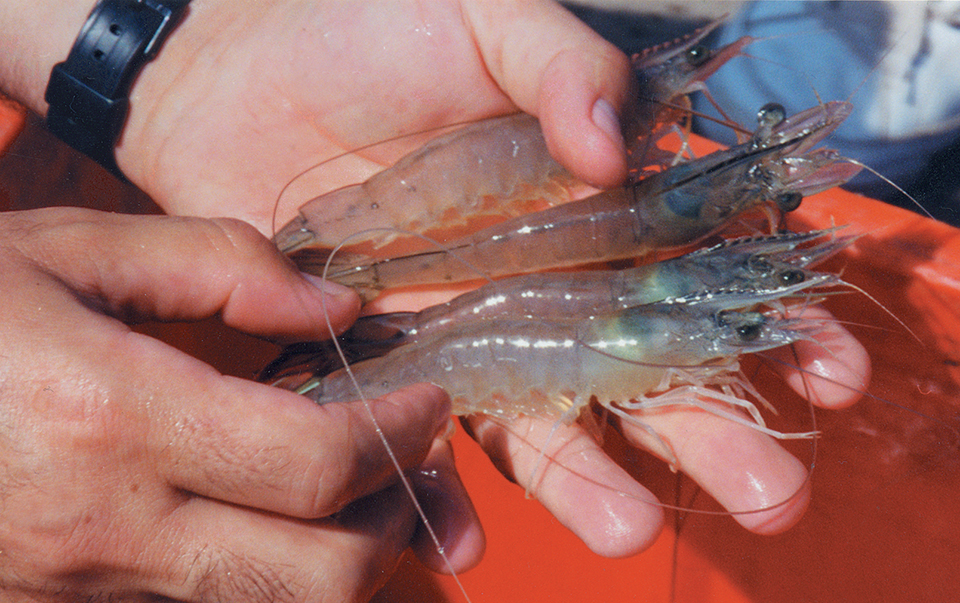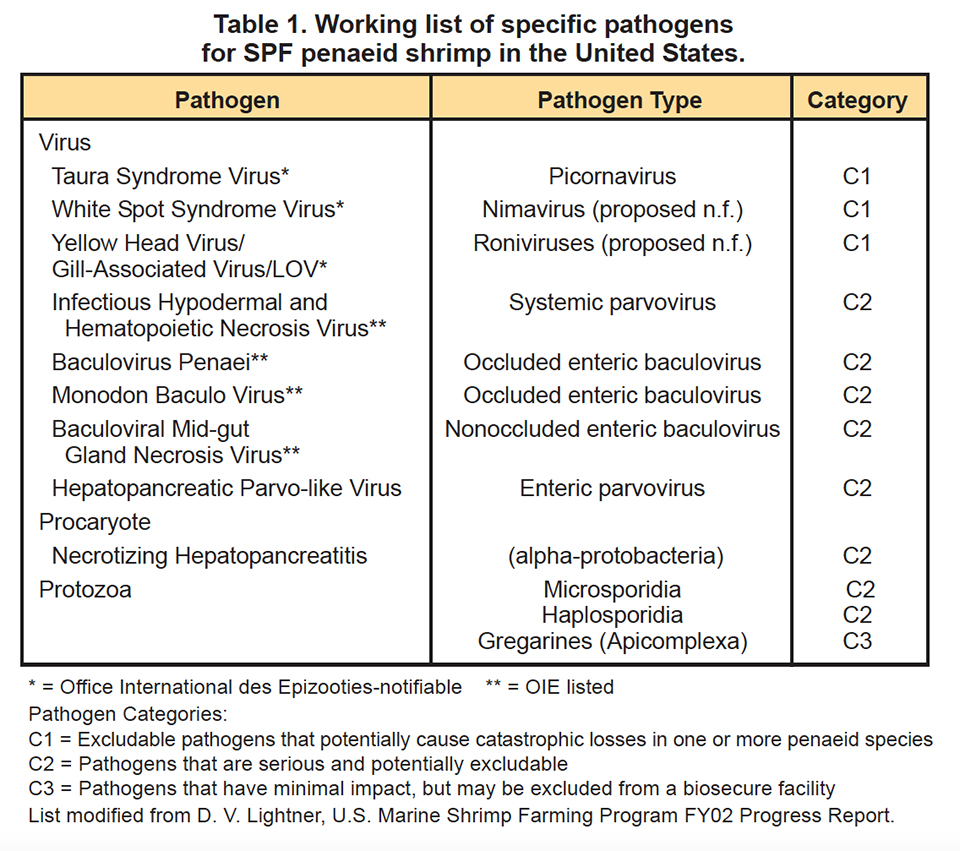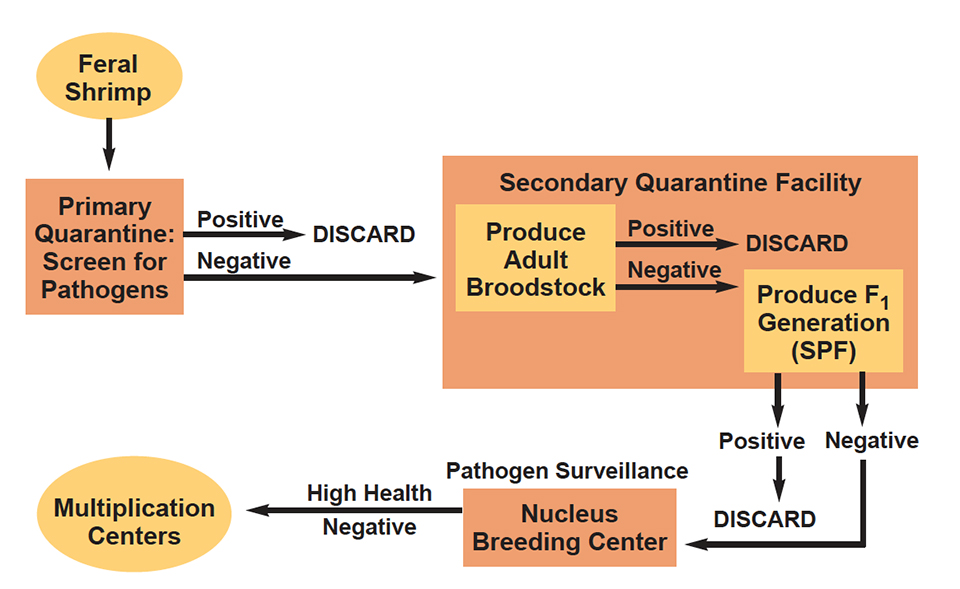SPF status depends on biosecurity levels

The contribution of farmed shrimp to the global penaeid shrimp supply increased from less than 10 percent in 1980 to over 50 percent in 2001. Despite the increases in shrimp aquaculture production over the past two decades, shrimp farmers have suffered tremendous economic losses from viral pathogens. Pandemics due to White Spot Syndrome Virus and Taura Syndrome Virus cost the shrimp industry billions of dollars in lost crops, jobs, and export revenue.
Shrimp farmers adopted numerous biosecurity measures to mitigate these losses, including the use of specific pathogen-free (SPF) shrimp. However, the SPF concept is not clearly understood by many stakeholders in the industry. In short, SPF designation refers to present pathogen status only, and is a function of the level of biosecurity where the shrimp are cultured.
SPF listing
An SPF shrimp is a shrimp free of specified pathogens. To be included on an SPF list, pathogens must be reliably diagnosed, able to be physically excluded from facilities, and pose a significant threat to the industry.
To date, there is no single, internationally recognized SPF list. The current working list of specific pathogens for SPF penaeid shrimp in the United States includes eight viruses, one prokaryote, and certain classes of parasitic protozoa (Table 1). It is important to note that SPF lists are dynamic and will be revised as new pathogens are identified and more accurate disease diagnostic tools become available.

SPF stock development
To develop an SPF stock from the wild, shrimp are collected and transferred to a primary quarantine facility, where they are analyzed for listed pathogens using appropriate diagnostic tools (Fig. 1). If shrimp test positive for any of the listed pathogens, they are destroyed in the primary quarantine facility. If shrimp test negative after several successive screenings, they are transferred to a secondary quarantine facility, where they mature and spawn to produce an F1 generation of captive shrimp.

Because some viruses can be transmitted from parent to offspring, representative shrimp from the F1 generation are analyzed for specifically listed pathogens. Some shrimp pathogens are not detectable until the shrimp are juveniles, so it is critical to quarantine and continue monitoring them for signs of infection or stress until they attain weights of at least 5 g.
It is also recommended that cohabitation studies be conducted with the candidate animals and known SPF shrimp that also are monitored for infection and stress. If shrimp from the F1 generation test negative for specifically listed pathogens after several screenings, they are transferred out of the secondary quarantine facility and can be included as part of the germ-plasm in a nucleus breeding center.
SPF status
Shrimp maintained in well-established breeding centers where there is a documented history of negative disease status can be designated SPF. However, once shrimp leave these facilities, they no longer are referred to as SPF, even though they may be free of specifically listed pathogens.
If shrimp are transferred from a documented SPF center to a medium-biosecurity facility, their new designation is “high health,” indicating the shrimp are at greater risk of pathogen exposure and infection. If shrimp are transferred to a low-biosecurity shrimp farm, they enter the commodity production stream, which is most vulnerable to pathogen outbreaks. These shrimp are neither SPF nor high health.
Status limitations
Although SPF shrimp are, by definition, free of all specifically listed pathogens, SPF shrimp can be infected with an unknown pathogen or a known pathogen not included on the SPF list of the shrimp supplier. Interestingly, although some members of the genus Vibrio can cause significant disease problems and be reliably diagnosed, they can not be included on an SPF list because, as ubiquitous members of shrimps’ normal flora, they can not be physically excluded from facilities.
Although a number of commercially important traits exhibited by shrimp are heritable, SPF status is not one of them. Offspring of SPF shrimp are not considered SPF unless they are produced and maintained at an SPF facility. SPF status changes with the pathogen condition of the shrimp, as well as the type of environment within which they are cultured.
SPF shrimp have no innate resistance to particular pathogens, nor are they innately susceptible. Disease resistance or susceptibility can be bred into a line of shrimp through selective breeding or other approaches, but this has no bearing on SPF status. SPF status is not an indication of shrimps’ genotypes.
Conclusion
Specific pathogen-free status depends on the presence or absence of specific pathogens in shrimp, and this status changes depending on the level of biosecurity where the shrimp are maintained. Shrimp farmers who want to purchase SPF shrimp need to ask what pathogens are on the supplier’s SPF list, what disease diagnostic tools were used to screen the shrimp, when the most recent disease screening was performed and by whom, what disease surveillance program the supplier follows to monitor his stock, and the disease history of the facility. In addition, purchasers of SPF shrimp should receive a copy of the most recent disease-screening results and appropriate certification.
The successful future of the global shrimp-farming industry is predicated on using bona fide SPF shrimp. It is incumbent on shrimp farmers worldwide to understand what SPF means and enforce this critically important biosecurity concept.
(Editor’s Note: This article was originally published in the December 2003 print edition of the Global Aquaculture Advocate.)
Now that you've finished reading the article ...
… we hope you’ll consider supporting our mission to document the evolution of the global aquaculture industry and share our vast network of contributors’ expansive knowledge every week.
By becoming a Global Seafood Alliance member, you’re ensuring that all of the pre-competitive work we do through member benefits, resources and events can continue. Individual membership costs just $50 a year. GSA individual and corporate members receive complimentary access to a series of GOAL virtual events beginning in April. Join now.
Not a GSA member? Join us.
Authors
-
Shaun M. Moss, Ph.D.
The Oceanic Institute
41-202 Kalanianaole Highway
Waimanalo, Hawaii 96795 USA[103,114,111,46,101,116,117,116,105,116,115,110,105,99,105,110,97,101,99,111,64,115,115,111,109,115]
-
Steve M. Arce
The Oceanic Institute
41-202 Kalanianaole Highway
Waimanalo, Hawaii 96795 USA -
Dustin R. Moss
The Oceanic Institute
41-202 Kalanianaole Highway
Waimanalo, Hawaii 96795 USA
Tagged With
Related Posts

Health & Welfare
Biosecurity principles for sustainable production using SPF shrimp
Basic components of biosecurity include knowledge of diseases, adequate detection methods and the use of “clean” shrimp stocks.

Health & Welfare
Blue alternative: High Health introduces SPF blue shrimp to Thailand
Blue shrimp are very similar to Pacific white shrimp, and can be raised under similar conditions. Blues grow faster and tolerate lower water temperatures.

Health & Welfare
Born in Hawaii, SPF broodstock shrimp industry faces globalization
The next step for shrimp breeding will be developing animals that aren’t just disease-free, but increasingly resistant to multiple pathogens. The industry is globalizing, with suppliers setting up shop overseas. But its birthplace will always be Hawaii.

Health & Welfare
A holistic management approach to EMS
Early Mortality Syndrome has devastated farmed shrimp in Asia and Latin America. With better understanding of the pathogen and the development and improvement of novel strategies, shrimp farmers are now able to better manage the disease.


